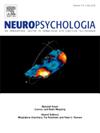Increase of phonological errors in dual-task conditions in patients with aphasia and neurotypical individuals: Impact of the verbal nature of the concurrent task
IF 2
3区 心理学
Q3 BEHAVIORAL SCIENCES
引用次数: 0
Abstract
Speaking is affected under dual-task conditions and studies have shown an impact on lexical and on phonological processes even in single word production. In the present study, we aimed at investigating if dual-task interference on lexical and phonological encoding is modulated by the linguistic nature of the concurrent task and in particular to determine whether the increase of phonological errors observed in previous studies using auditory syllables as concurrent stimuli is due to the phonological overlap between the tasks.
Patients with aphasia (PWA, Experiment 1) and neurotypical individuals (Experiment 2) underwent a picture naming task and an auditory detection task of non-verbal sounds of daily life under single and dual-task conditions with different stimulus onset asynchronies (SOAs), namely +150 and + 300 ms, likely targeting lexical processes and phonological encoding. In both groups, naming latencies were slower under dual-task conditions at each SOA and in PWA, phonological errors increased with sounds of daily life presented at SOA +300. The results on errors replicate what was observed previously in studies using syllables as concurrent auditory stimuli in PWA. To investigate whether the increase of errors is larger with syllables relative to non-verbal sounds independent of the clinical condition, another neurotypical group performed a dual-task paradigm with syllables as concurrent auditory stimuli (Experiment 3).
Results
showed an increase of phonological errors at late SOA also in neurotypical participants, thus confirming the impact of concurrent syllables on phonological errors independently of the population.
The results indicate that non-verbal auditory stimuli in the concurrent task impact phonological errors, although to a lesser extent than syllables, suggesting that the increase of errors in previous studies cannot be entirely attributed to the phonological overlap between the tasks.
失语症患者和神经正常个体在双重任务条件下语音错误的增加:并发任务的言语性质的影响
在双重任务条件下,说话受到影响,研究表明,即使在单字生产中,词汇和语音过程也会受到影响。在本研究中,我们旨在调查双任务对词汇和语音编码的干扰是否受到并发任务的语言性质的调节,特别是确定在以往使用听觉音节作为并发刺激的研究中观察到的语音错误的增加是否由于任务之间的语音重叠。实验1中,失语症患者(PWA)和神经正常个体(实验2)分别在+150 ms和+ 300 ms刺激启动异步(SOAs)的单任务和双任务条件下进行图片命名任务和日常生活非言语语音的听觉检测任务,可能针对词汇加工和语音编码。在两组中,在每个SOA的双任务条件下,命名延迟较慢,而在PWA中,语音错误随着SOA +300的日常生活声音而增加。错误的结果重复了先前在使用音节作为PWA并发听觉刺激的研究中观察到的结果。为了研究是否独立于临床条件的音节相对于非言语声音的错误增加更大,另一组神经典型组进行了双任务范式,将音节作为并发听觉刺激(实验3)。结果显示,在SOA晚期,神经典型参与者的语音错误也增加了,从而证实了并发音节对语音错误的影响独立于人群。结果表明,并发任务中的非言语听觉刺激对语音错误的影响程度低于音节,这表明先前研究中错误的增加不能完全归因于任务之间的语音重叠。
本文章由计算机程序翻译,如有差异,请以英文原文为准。
求助全文
约1分钟内获得全文
求助全文
来源期刊

Neuropsychologia
医学-行为科学
CiteScore
5.10
自引率
3.80%
发文量
228
审稿时长
4 months
期刊介绍:
Neuropsychologia is an international interdisciplinary journal devoted to experimental and theoretical contributions that advance understanding of human cognition and behavior from a neuroscience perspective. The journal will consider for publication studies that link brain function with cognitive processes, including attention and awareness, action and motor control, executive functions and cognitive control, memory, language, and emotion and social cognition.
 求助内容:
求助内容: 应助结果提醒方式:
应助结果提醒方式:


